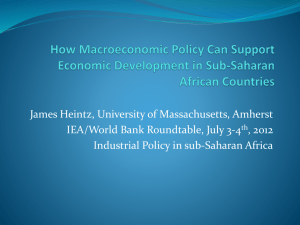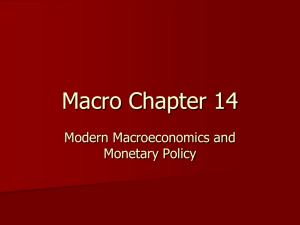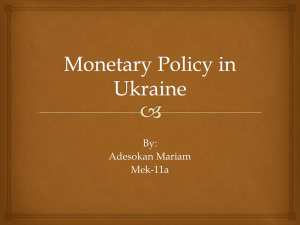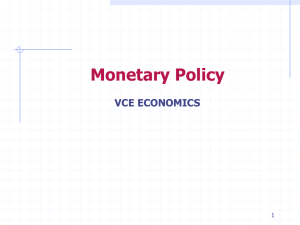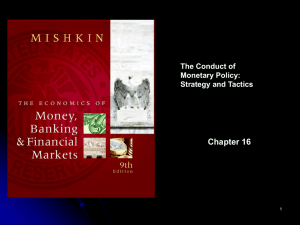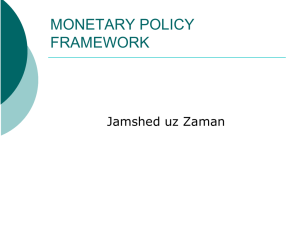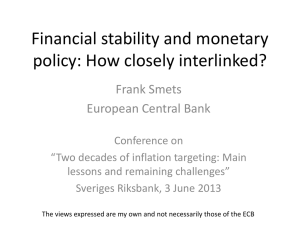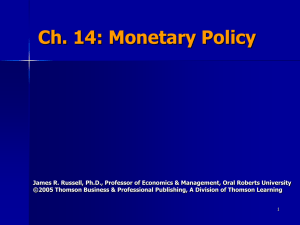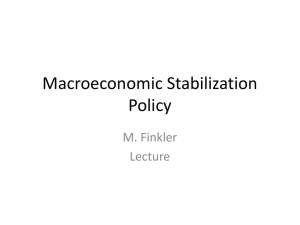monetary and exchange rate policies in malawi
advertisement
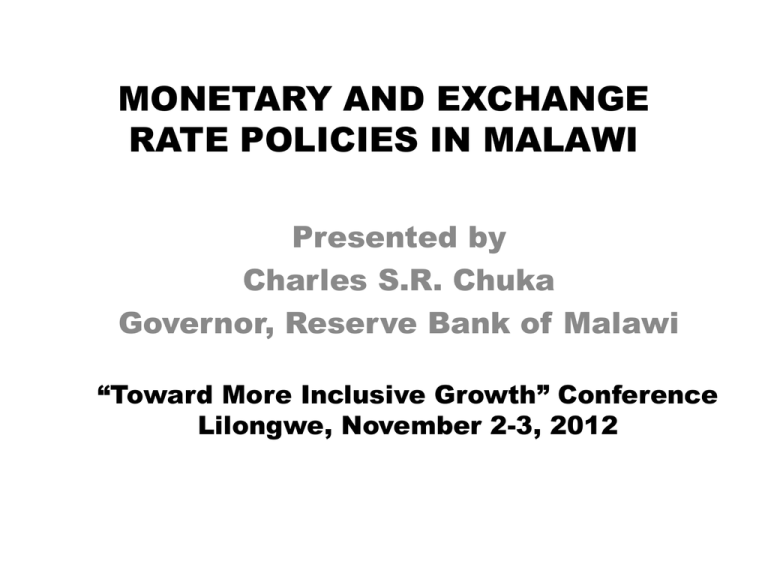
MONETARY AND EXCHANGE RATE POLICIES IN MALAWI Presented by Charles S.R. Chuka Governor, Reserve Bank of Malawi “Toward More Inclusive Growth” Conference Lilongwe, November 2-3, 2012 Outline • Introduction • Evolution of Monetary and Exchange Rate Policies • Recent Monetary and Exchange Rate Policies changes • Policy Challenges • Outlook • Conclusion 2 Key Points • Inflation being driven by food scarcities • Exchange rate instability reflects continuing liquidity overhang • Monetary policy focusing on tightening M2 growth 3 Structure of the Economy 1980 1990 2000 2010 2011 2012 Agriculture, forestry and fishing 32.7 21.6 22.6 27.8 28.3 27.0 Wholesale and retail trade 12.7 8.2 12.1 20.7 20.6 20.6 Manufacturing 10.2 8.8 7.5 10.6 10.3 9.2 Transportation and Communication 6.0 3.8 2.4 3.8 3.8 3.9 Financial/Professional Services 6.0 4.4 4.6 2.1 2.1 2.1 Construction and Building 5.0 2.7 1.3 3.2 3.0 3.5 Electricity, Gas and Water Supply 1.6 1.5 0.8 1.5 1.5 1.5 Mining and Quarrying 0.0 0.0 0.8 2.3 2.1 2.6 Share of trading activities doubled 4 GDP Outturn Agriculture and manufacturing output revised downwards 5 Objectives of Monetary and Exchange Rate Policies • Main objective: Price and Financial Stability • Other objectives: Sustainable balance of payments and economic growth • Exchange Rate policy is aimed at external competitiveness 6 Evolution of Monetary & Exchange Rate Policies Period Monetary Policy Exchange Rate Lending Policy 1964-1986 o (Financial o Repression) o 1987-1993 o (Financial Reforms) o o o Interest rate controls Preferential lending to agricultural sector Price control on selected commodities 1987deregulation of lending rates 1988deregulation of deposit rates 1989-Review of the Banking Act 1990-abolition of preferential lending rates Fixed F/work Exchange Credit Rate regime growth n Rate 5.0 7.8 3.3 19.0 controls Pegged to a basket Deregulate of currencies Real GDP Inflatio d lending 7 Evolution of Monetary & Exchange Rate Policies Period Monetary Policy Exchange Rate Policy Lending Real Inflation F/work GDP Rate growth o 1994-2007 (financial liberalization) o o 2008-April 2012: liberalized financial Indirect Monetary Policy instruments: Discount rate, OMO, LRR New commercial banks entered the system o o Free float Deregulated Partial deregulation of lending exchange controls establishment of foreign exchange bureau establishment of FCDA establishment of foreign exchange market, 3.2 30.4 Indirect Monetary Policy instruments: Discount rate, OMO, LRR Defacto fixed exchange Rate Deregulated with administrative controls lending over current account transactions 6.0 10.4 Indirect Free float with liberalized Deregulated Monetary Policy current account transactions lending instruments: Discount rate, OMO, LRR 1.6 20.1 o o o sector) May 2012- to o date; (liberalized fin. sector) 8 Monetary and Exchange Rate Policy Framework & Instruments • Reserve Money Programming (NDA + NFA) –Discount Rate –Open Market Operations –Foreign Exchange Operations –Liquidity Reserve Requirements –Moral Suasion/Signalling • Exchange rate regime: Managed Float 9 M2 and Reserve Money •M2 managed through reserve money 10 Lending rates and M2 Low real lending rates pushing M2 11 Domestic Credit Developments K'billion Percent 450 50 400 40 350 30 300 20 250 200 10 150 0 100 -10 50 -20 Domestic Credit Sep-12 Dec-11 Mar-11 Jun-10 Sep-09 Dec-08 Mar-08 Jun-07 Sep-06 Dec-05 Mar-05 Jun-04 Sep-03 Dec-02 Mar-02 Jun-01 Sep-00 Dec-99 Mar-99 Jun-98 Sep-97 Dec-96 -50 Mar-96 0 -30 Real Lending Rates (right Scale) Domestic credit declining 12 Mar-90 Dec-90 Sep-91 Jun-92 Mar-93 Dec-93 Sep-94 Jun-95 Mar-96 Dec-96 Sep-97 Jun-98 Mar-99 Dec-99 Sep-00 Jun-01 Mar-02 Dec-02 Sep-03 Jun-04 Mar-05 Dec-05 Sep-06 Jun-07 Mar-08 Dec-08 Sep-09 Jun-10 Mar-11 Dec-11 Sep-12 Inflation Driven by Food Prices Percent 120.0 100.0 80.0 60.0 40.0 20.0 0.0 Headline Inflation Food Inflation 13 Inflation Sources Source: National Statistics Office Manage food prices -20.0 Inflation Sep-12 Dec-11 Mar-11 Jun-10 Sep-09 Dec-08 Mar-08 Jun-07 Sep-06 Dec-05 Mar-05 Jun-04 Sep-03 Dec-02 Mar-02 Jun-01 Sep-00 Dec-99 Mar-99 Jun-98 Sep-97 Dec-96 Mar-96 Jun-95 Sep-94 Money Supply & Inflation Percent 120.0 100.0 80.0 60.0 40.0 20.0 0.0 M2 Growth M2 impact on inflation unclear (Long lag?) 15 Sources of M2 Growth K' billion 400 M2 decelerating, Credit to Govt. decelerating 350 300 250 200 150 100 50 M2 Net Credit to Government Sep-12 Dec-11 Mar-11 Jun-10 Sep-09 Dec-08 Mar-08 Jun-07 Sep-06 Dec-05 Mar-05 Jun-04 Sep-03 Dec-02 Mar-02 Jun-01 Sep-00 Dec-99 Mar-99 Jun-98 Sep-97 Dec-96 -50 Mar-96 0 Private Sector Credit 16 Exchange Rate and Inflation 17 Impact of Fixed Exchange Rate Policies • • • • • Loss of foreign exchange reserves Import backlog accumulated Fuel scarcity Downsizing by companies GDP growth was reducing 18 Recent Policy Reforms • Exchange Rate floated May 2012 • Bank rate was adjusted upwards twice-May and July 2012 • Fuel pricing is now based on Automatic Pricing Mechanism 19 Recent Policy Reforms (cont’d) • RBM sold about US$220 million between May and August 2012 compared to US$37.7 million sold in similar period in 2011 • Tobacco proceeds re-routed through commercial banks • RBM provided liquidity to stressed banks 20 Recent Policy Reforms (cont’d) 21 Recent Policy Reforms (cont’d) Percent Percent Exchange Rate Depreciation 60 30.0 Annual Inflation (right scale) 50 25.0 40 20.0 30 15.0 20 10.0 10 5.0 0 Sep-12 Aug-12 Jul-12 Jun-12 May-12 Apr-12 Mar-12 Feb-12 Jan-12 -10 0.0 22 Recent Policy Reforms (cont’d) 23 Recent Policy reforms, cont’d Exchange Rates: Commercial and Bureau rates •Commercial Banks and Bureau rates are now converging 24 Recent Policy reforms, cont’d Gross Official Reserves (GOR) Gross Official Reserves started to improve in July 2012 25 Policy Reforms (Cont’d) 26 Challenges • Containing M2 growth at current levels will depend on successful rollover of domestic debt • Monetary policy space is declining • Pressure on exchange rate is likely to persist due to seasonal factors • Limited supply of foreign exchange • M2 growth is slowing down but inflation is rising 27 Lessons • Inflationary pressures remain • GDP growth still positive • Exchange rates aligned 28 Outlook • Foreign exchange shortages are envisaged to persist as seasonally expected • Given the obtaining macroeconomic fundamentals, there is need to tighten further monetary policy or maintain the current tight stance. 29 Conclusion • Given the current macro-scenario, threats of inflation pressures still persist. • The question is to what extent can monetary policy still tighten without severe adverse effects on the economy? 30 Thank You 31
